Glow Worm (AngryOrange) – $0.99
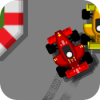
Retro Racing-What’s in a Name? Everything.
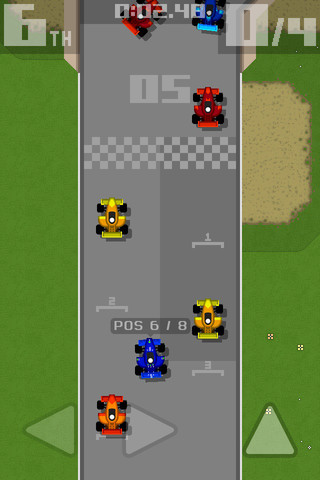
Controls
In Retro Racing, the controls are fairly simple: tap on the forward arrow to go forward and the sideways ones to go sideways (sometimes called turning.) If when playing this game you can’t understand that, even after the tutorial, and you aren’t a cat, I will personally write a letter of apology to your pride. Anyhow, the controls work alright, but they feel very cramped, mainly on iPhones or iPod Touches (on the iPad it’s much better.) One nice option would be an ‘auto-gas with left and right arrows on the sides’ control scheme or a landscape mode, both of which might help ease the controls’ weaknesses. Still, the current controls just don’t seem good enough most of the time. At times they work decently, but the sensitivity sometimes can be hard to judge even then, leading to crashes in-game. Most of the time though, they work fairly well, but they don’t provide the best possible execution consistently.
3.5/5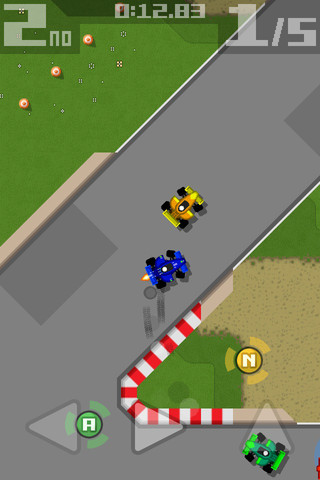
Graphics/Gameplay
As the name implies, Retro Racing employs retro-styled graphics. While they’re not stunning, they get the job done perfectly well. It also plays great and is very enjoyable. As you could guess, the goal is to race through each level as fast as you can and to get first place. There are leaderboards for every track, fitting the style and pace of the game. There’s also a nifty two-player mode which pits you against another opponent (one-device only), which works very well and is really fun as well, even on the smaller iPhone. This is available for both iPhone and iPad after the recent update. Each race also has a variety of “power-ups” that boost your stats, plus nitro boosts as well. These make the game fun and fresher at its lower moments. While its still a stereotypical racing game in many aspects, it creates a fun-filled nostalgic game.
4.5/5
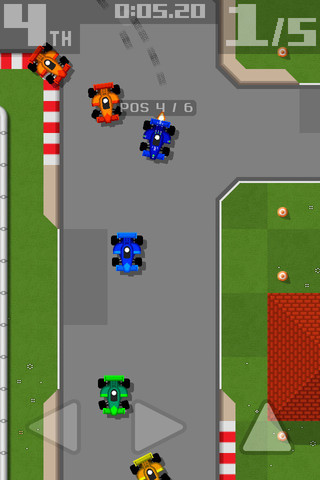
Level Design
The highlight of the game, though, lies in its nifty level design. In most racing games, the level’s just the track and where it turns. That’s not the case in ‘Retro Racing’. Each level is packed with a good amount of power-ups, extra paths, and more that make each level fresh and fun. False turns, cones, walls, and other cars all stand in the way of you and the finish line. The most enjoyable part of the game is how much the level design plays a part into the game. A nitro power-up could propel you into first place. Crashing into cones could lose you a position, while turning on a false turn could destroy your shot at taking the checkered flag. The level never feels unjustly made; even the frustrating moments make me want to play more. Each level feels carefully made to be the best it can be, and in turn propels the game
5/5
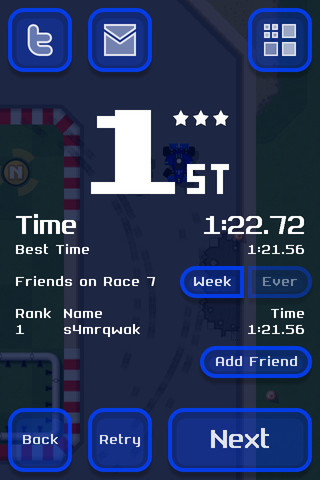
Balance
The weakest point in the game, however, lies in its balancing. If you ever want to achieve a score anywhere high in the leaderboards you have to purchase an extra $.99 car pack, which unlocks the final three cars, meaning that if you care about that type of thing, you will be wanting to buy the iAP, which seems missing in tact and unfair. The game feels somewhat balanced in its ‘campaign’, with the basic cars (and very rewarding when you win) but would get too easy with the iAP cars since their stats are over twice as high as the best of the basic cars. Plus, all the basic cars are unlocked from the get-go, meaning there’s no sense of progression there, besides levels. Often times that’s simply not enough, which can lead the game down some dire straits.
3/5
Overall:
Retro Racing is a nice game weakened by so-so controls and imperfect balancing. However, if you’re a fan of the ‘retro’ or of the ‘racing’ then these problems are easily overcome by the sweet level design and fun gameplay, providing a very fun approach to the racing genre.
4/5
Have you ever wanted to be the wind? In a few weeks you’ll get your chance with Dont Step On The Cracks’ ‘On The Wind’. From what we know, On The Wind will be a sort of survival runner where your goal is to try to keep a group of leaves drifting in the air. The game will be sporting some awesome, crisp and stylish artwork with calm ‘windy’ music to go with it. Apart from the fantastic visual appeal, the gameplay in On The Wind will be driven by the struggle to “survive” through each season. Leaves will be plentiful in the spring, but in the winter it will be difficult to get by. In terms of controls, it will be a simple, one-touch and drag to direct the wind.
On The Wind is looking really good so far. Randomly generated worlds should keep the game fresh each time you play, and GameCenter integration means loads of achievements and competitive leaderboards. Be looking for On The Wind in the next few weeks. Until then, check out the complete feature list along with the trailer and a handful of screenshots on Don’t Step On The Cracks’ official website.
On The Wind Features:
– Full retina graphics for the new iPad
– Simple and intuitive ‘one touch’ controls
– Relaxing play with the soothing sound of the wind, or challenge yourself to beat your friends
– Beautiful world that’s generated as you play so it’s different every time
– Game Center enabled with lots of tricky achievements, and leader boards to challenge your friends
– Universal app, buy once and play on your iPhone, iPod and iPad.
It’s been quiet here at the App Shack, but that is the sign of a long and arduous week. Thankfully there has been a break in the onslaught, and we are back with an exciting interview with Rodeo Games (the brains behind the Hunters series). With Hunters 2 releasing this week, hopefully this article gets you excited for the game if you aren’t already. Watch for our review soon.
Initials stand for Ben Murch, Adam Clixby and Richard Brooks.
BM: We were all friends before Rodeo formed. Laurent was my next door neighbour when I first moved to Guildford. Adam, Rich and I all worked together at Codemasters. Then two things happened. Firstly, the App Store appeared, which empowered people like us to make and publish the games we wanted. Secondly, Laurent and I got stranded in Vegas for an extra week when the whole volcano ash cloud thing happened. In between all the gambling and drinking, we outlined what to do and hit the ground running with Adam and Rich when we got back!
BM: I really hope not! The Hunters universe is pretty bleak. A sort of morally bankrupt place where killing people is seen as a means to get paid! Private corporations running things though, that seems more believable. You can already see the current world going that way a little now, and you can imagine someone like Branson landing on Mars and claiming it in the name of Virgin.
BM: Haha, good spot! It was originally in there for a joke, because that Hunter had 100% accuracy when we were testing the game. Then we just got attached to the name. It seems to fit for some reason.
RB: From a technical point of view, using a top-down camera allows us to do a lot to make the game look as good as it does. It means we can keep the fidelity of the graphics really high.
BM: Yes, our choice of viewing angle is mostly based on the nature of the game. Top down is the most effective for turn based strategy. The whole up close and personal view could be cool for kill-cams, but the amount of work we’d have to do to get it in the game wouldn’t be worth the payoff!
AC: Absolutely. The daily contract system is something we really liked about the first game – and something we got a lot of positive feedback about. By getting a new set of contracts each day, you really want to keep coming back – it keeps the game feeling fresh.
Something else we’ve included in Hunters 2 after a lot of requests is a ‘hardcore’ mode in which your hunters are permanently removed from the game if they are killed on a mission. It makes for some very tense (and cowardly) play!
BM: We’ve also totally revamped the talents system. It’s now more dynamic and personalised than before. Each hunter has access to general talents and two specialist trees. Figuring out which combinations work for your style of play is really cool.
– What do you guys have planned for after Hunters 2? Will there be a third installment?
BM: We do have something really really awesome lined up, but we can’t talk about it just yet.